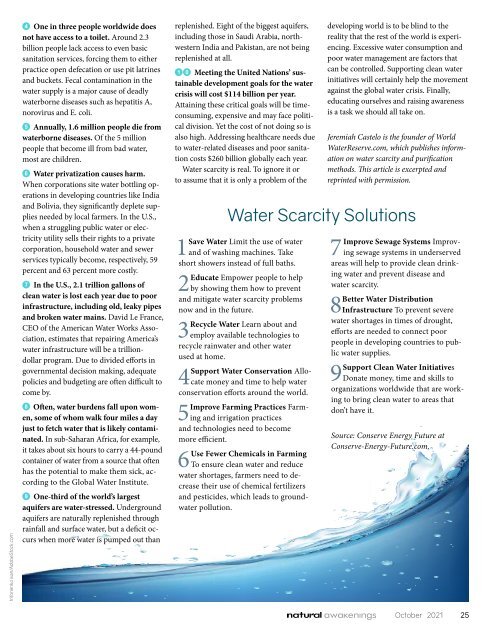Natural Awakenings Twin Cities October 2021
Read the October 2021 edition of Natural Awakenings Twin Cities magazine. This is our annual Healthy Planet Issue which is focused on Living a Simpler Lifestyle and Breast Health. Topics also include the fall fruit recipes, water scarcity, tips on grieving, talking with your children about climate change, cannabis for your pets and so much more! Be sure to check out our local content including News Briefs announcements, Community Resource Guide with providers throughout the metro who can meet your individual wellness needs, and all the happenings in the Calendar of Events. There is additional online-only content that can be found at NATwinCities.com. While you are there, be sure to sign up for our Newsletter and Digital Magazine and continue your reading with our archived articles from local experts.
Read the October 2021 edition of Natural Awakenings Twin Cities magazine. This is our annual Healthy Planet Issue which is focused on Living a Simpler Lifestyle and Breast Health. Topics also include the fall fruit recipes, water scarcity, tips on grieving, talking with your children about climate change, cannabis for your pets and so much more!
Be sure to check out our local content including News Briefs announcements, Community Resource Guide with providers throughout the metro who can meet your individual wellness needs, and all the happenings in the Calendar of Events. There is additional online-only content that can be found at NATwinCities.com.
While you are there, be sure to sign up for our Newsletter and Digital Magazine and continue your reading with our archived articles from local experts.
Create successful ePaper yourself
Turn your PDF publications into a flip-book with our unique Google optimized e-Paper software.
trifonenko ivan/AdobeStock.com<br />
One in three people worldwide does<br />
not have access to a toilet. Around 2.3<br />
billion people lack access to even basic<br />
sanitation services, forcing them to either<br />
practice open defecation or use pit latrines<br />
and buckets. Fecal contamination in the<br />
water supply is a major cause of deadly<br />
waterborne diseases such as hepatitis A,<br />
norovirus and E. coli.<br />
Annually, 1.6 million people die from<br />
waterborne diseases. Of the 5 million<br />
people that become ill from bad water,<br />
most are children.<br />
Water privatization causes harm.<br />
When corporations site water bottling operations<br />
in developing countries like India<br />
and Bolivia, they significantly deplete supplies<br />
needed by local farmers. In the U.S.,<br />
when a struggling public water or electricity<br />
utility sells their rights to a private<br />
corporation, household water and sewer<br />
services typically become, respectively, 59<br />
percent and 63 percent more costly.<br />
In the U.S., 2.1 trillion gallons of<br />
clean water is lost each year due to poor<br />
infrastructure, including old, leaky pipes<br />
and broken water mains. David Le France,<br />
CEO of the American Water Works Association,<br />
estimates that repairing America’s<br />
water infrastructure will be a trilliondollar<br />
program. Due to divided efforts in<br />
governmental decision making, adequate<br />
policies and budgeting are often difficult to<br />
come by.<br />
Often, water burdens fall upon women,<br />
some of whom walk four miles a day<br />
just to fetch water that is likely contaminated.<br />
In sub-Saharan Africa, for example,<br />
it takes about six hours to carry a 44-pound<br />
container of water from a source that often<br />
has the potential to make them sick, according<br />
to the Global Water Institute.<br />
One-third of the world’s largest<br />
aquifers are water-stressed. Underground<br />
aquifers are naturally replenished through<br />
rainfall and surface water, but a deficit occurs<br />
when more water is pumped out than<br />
replenished. Eight of the biggest aquifers,<br />
including those in Saudi Arabia, northwestern<br />
India and Pakistan, are not being<br />
replenished at all.<br />
Meeting the United Nations’ sustainable<br />
development goals for the water<br />
crisis will cost $114 billion per year.<br />
Attaining these critical goals will be timeconsuming,<br />
expensive and may face political<br />
division. Yet the cost of not doing so is<br />
also high. Addressing healthcare needs due<br />
to water-related diseases and poor sanitation<br />
costs $260 billion globally each year.<br />
Water scarcity is real. To ignore it or<br />
to assume that it is only a problem of the<br />
Water Scarcity Solutions<br />
1Save Water Limit the use of water<br />
and of washing machines. Take<br />
short showers instead of full baths.<br />
Educate Empower people to help<br />
2 by showing them how to prevent<br />
and mitigate water scarcity problems<br />
now and in the future.<br />
3Recycle Water Learn about and<br />
employ available technologies to<br />
recycle rainwater and other water<br />
used at home.<br />
4Support Water Conservation Allocate<br />
money and time to help water<br />
conservation efforts around the world.<br />
Improve Farming Practices Farming<br />
and irrigation practices 5<br />
and technologies need to become<br />
more efficient.<br />
Use Fewer Chemicals in Farming<br />
6 To ensure clean water and reduce<br />
water shortages, farmers need to decrease<br />
their use of chemical fertilizers<br />
and pesticides, which leads to groundwater<br />
pollution.<br />
developing world is to be blind to the<br />
reality that the rest of the world is experiencing.<br />
Excessive water consumption and<br />
poor water management are factors that<br />
can be controlled. Supporting clean water<br />
initiatives will certainly help the movement<br />
against the global water crisis. Finally,<br />
educating ourselves and raising awareness<br />
is a task we should all take on.<br />
Jeremiah Castelo is the founder of World<br />
WaterReserve.com, which publishes information<br />
on water scarcity and purification<br />
methods. This article is excerpted and<br />
reprinted with permission.<br />
7Improve Sewage Systems Improving<br />
sewage systems in underserved<br />
areas will help to provide clean drinking<br />
water and prevent disease and<br />
water scarcity.<br />
Better Water Distribution<br />
8 Infrastructure To prevent severe<br />
water shortages in times of drought,<br />
efforts are needed to connect poor<br />
people in developing countries to public<br />
water supplies.<br />
Support Clean Water Initiatives<br />
9 Donate money, time and skills to<br />
organizations worldwide that are working<br />
to bring clean water to areas that<br />
don’t have it.<br />
Source: Conserve Energy Future at<br />
Conserve-Energy-Future.com.<br />
<strong>October</strong> <strong>2021</strong><br />
25

















